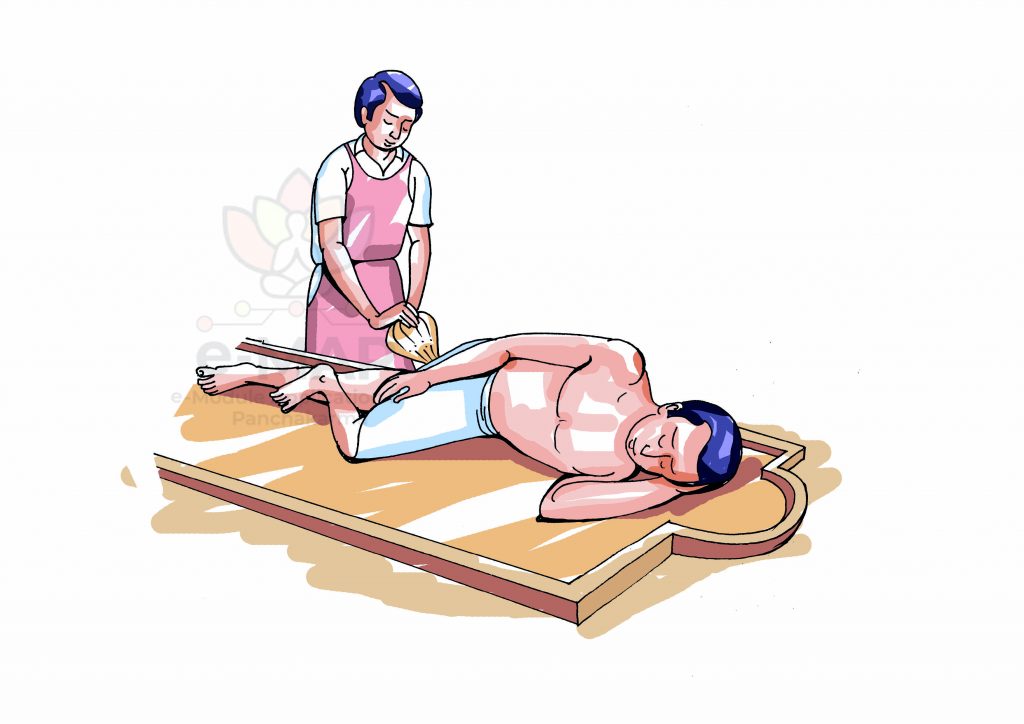
PG Module 6
BASTI KARMA

EXPLANATORY NOTES
- निरूह-मात्राप्रथमेप्रकुञ्चोवत्सरेपरम्।
प्रकुञ्च-वृद्धिःप्रत्य्-अब्दंयावत्षट्प्रसृतास्ततः॥१८॥
प्रकुञ्चोवत्सरात्परम्प्रसृतंवर्धयेद्ऊर्ध्वंद्वा-दशाष्टा-दशस्यतु ।
आ-सप्ततेर्इदंमानंदशैवप्रसृताःपरम् ॥ १९ ॥
द्वा-दशाष्टा-दशस्य च यथा-यथंनिरूहस्यपादोमात्रानुवासने ।(A.Hr.Su.19/18-19)
- निरूहमात्रा प्रसृतार्धमाद्ये वर्षे ततोऽर्धप्रसृताभिवृद्धिः||३१||
आद्वादशात् स्यात् प्रसृताभिवृद्धिरष्टादशाद् द्वादशतः परं स्युः|
आसप्ततेस्तद्विहितं [१]प्रमाणमतः परं षोडशवद्विधेयम्||३२||
निरूहमात्रा प्रसृतप्रमाणा बाले च वृद्धे च मृदुर्विशेषः|३३| (Si.3/31-33)
- यथावयो निरूहाणां या मात्राः परिकीर्तिताः |
पादावकृष्टास्ताः कार्याः स्नेहबस्तिषु देहिनाम् ||४||(Su.chi.37/4)
- निरूहपादांशसमेनतैलेनेति निरूहपादप्रमाणेन, चतुर्विंशतिपले निरूहे षट्पलेन स्नेहेनेत्यर्थः; इयं चोत्तमा मात्राऽनुवासनस्य; उक्तं ह्यन्यत्र– “उत्तमा षट्पली प्रोक्ता मध्यमा त्रिपली भवेत्| कनीयसी [३] सार्धपला त्रिधा मात्राऽनुवासने” इति; सुश्रुतेऽप्येतावन्मानमेव स्नेहस्यानुवासन मात्राबस्तिविभागेनानुवासने उक्तम्| (Cha.si.onCh.Pa3/27-29)
Age | Caraka | Suśruta | Vāgbhaṭa |
1 year | ½ Prasṛta | 1 Prakuñca | 4 Tola |
2 years | 1 Prasṛta | 2 Prakuñca | 8 Tola |
3 years | 1 ½ Prasṛta | 3 Prakuñca | 12 Tola |
4 years | 2 Prasṛta | 4 Prakuñca | 16 Tola |
5 years | 2 ½ Prasṛta | 5 Prakuñca | 20 Tola |
6 years | 3 Prasṛta | 6 Prakuñca | 24 Tola |
7 years | 3 ½ Prasṛta | 7 Prakuñca | 28 Tola |
8 years | 4 Prasṛta | 8 Prakuñca | 32 Tola |
9 years | 4 ½ Prasṛta | 9 Prakuñca | 36 Tola |
10 years | 5 Prasṛta | 10 Prakuñca | 40 Tola |
11 years | 5 ½ Prasṛta | 11 Prakuñca | 44 Tola |
12 years | 6 Prasṛta | 12 Prakuñca | 48 Tola |
13 years | 7 Prasṛta | 7 Prasṛta | 56 Tola |
14 years | 8 Prasṛta | 8 Prasṛta | 64 Tola |
15 years | 9 Prasṛta | 9 Prasṛta | 72 Tola |
16 years | 10 Prasṛta | 10 Prasṛta | 80 Tola |
17 years | 11 Prasṛta | 11prasṛta | 88 Tola |
18 years | 12 Prasṛta | 12 Prasṛta | 96 Tola |
19-70 years | 12 Prasṛta | 12 Prasṛta | 96 Tola |
Above 70 | 10 Prasṛta | 10 Prasṛta | 80 Tola |
(1 Tola = 12.5 g; 1 Prasṛta = 100 g)
BASTI MIŚRAṆA
पूर्वं हि दद्यान्मधु सैन्धवं तु स्नेहं विनिर्मथ्यं ततोऽनु कल्कम्||२३||
विमथ्य संयोज्य पुनर्द्रवैस्तं बस्तौ निदध्यान्मथितं [१] खजेन|२४| (Cha.si.3/13-14)
In the beginning Madhu and Saindhava should be taken and then add Sneha and it should be well mixed. Thereafter the Kalka of Dravyas should be added and mixed again. Later to this the Kaṣāya is added and mixed well (Manthana) is done with the Khajam. This prepared Basti Dravya is poured to the Basti Puṭaka.
माक्षिकंलवणंस्नेहंकल्कंक्वाथम्इतिक्रमात्॥४५॥
आवपेतनिरूहाणाम्एषसंयोजनेविधिः। (A.Hr.Su.19/45)
The order of mixing the Nirūha Basti are Mākshika, Lavana, Sneha, Kalka, Kvātha And Āvāpa are to be mixed in succeeding order.
KALKA DRAVYA
पूतं यवानीफलबिल्वकुष्ठवचाशताह्वाघनपिप्पलीनाम्|| (Cha.Si3/14) ||
It is called as Yavānyadi Kalka. It comprises of eight Dravyas such as Yavāni, Madanaphala, Bilva, Kuṣṭha, Vacā, Śatāhva, Mustā and Pippali. These are taken in equal quantity mostly 1 Tola.
SNEHA
- नत्वामं प्रणयेत् स्नेहं स ह्यभिष्यन्दयेद्गुदम्| (Cha.Si.4/48)
- आममितिअपक्वम्| (Cha.Si.4/48)
Unprocessed Sneha (Āma Sneha) should not be used for Basti, as it produces Abhiṣyanda in the Guda.
आमःअपक्वस्नेहः| (Su. Chi. 35/32, Ḍalhaṇa Commentary)
According to ĀcāryaSuśruta, Āmata is one among the Nirūha Basti DravyaDoṣa.Āmata is Apakva Sneha (unprocessed Sneha). So Apakva Sneha should not be used for Nirūha Basti.
पित्ते स्नेहस्य षष्ठः प्रकृतौ स्थिते च||३०||
वाते विवृद्धे तु चतुर्थभागो, मात्रा निरूहेषु कफेऽष्टभागः|३१| (Cha.si.3/30-31)
In PaittikaVikāras and Svastha, the quantity of Sneha should be 1/6th of the total quantity of Nirūha Basti.
In VātajaVikāras, the quantity of Sneha should be 1/4th of the total quantity of Nirūha Basti.
In KaphajaVikāras, the quantity of Sneha should be 1/8th of the total quantity of Nirūha Basti.
मृदुर्नस्ये, खरोऽभ्यङ्गे, पानेबस्तौ च चिक्कणः|| (A. H. Ka. 6/21)
According to ĀcāryaVāgbhaṭa, Cikkaṇa (Mṛdu) Pāka Sneha is used for Basti Karma. ĀcāryaCaraka mentioned Madhyama Sneha Pakaand ĀcāryaSuśruta mentioned Khara Sneha Paka for Basti Karma.
KAṢĀYA
भागाः कषायस्य तु पञ्च, (Cha.Si.3/30)
The quantity of Kaṣāya taken is 5 Prasṛta or 10 Pala.
Quantity of each ingredient
दत्त्वाऽऽदौ सैन्धवस्याक्षं मधुनः प्रसृतद्वयम् |
पात्रे तलेन मथ्नीयात्तद्वत् स्नेहं [१] शनैः शनैः ||३३||
सम्यक् सुमथिते दद्यात् फलकल्कमतः परम् |
ततो यथोचितान् कल्कान् भागैः स्वैः श्लक्ष्णपेषितान् ||३४||
गम्भीरे भाजनेऽन्यस्मिन्मथ्नीयात्तं खजेन च |
यथा वा साधु मन्येत न सान्द्रो न तनुः समः ||३५||
रसक्षीराम्लमूत्राणां दोषावस्थामवेक्ष्य तु |
कषायप्रसृतान् पञ्च सुपूतांस्तत्र दापयेत् ||३६|| (Su.Chi.38/33-36)
First one AkṣaSaindhava and 2 Prasṛta Madhu should be taken in an utensil and should be churned with palm, later Sneha should be added little by little and churned well followed by Kalka. Later the whole mixture is taken in bigger vessel and added with filtered Kaṣāya in quantity of 5 Prasṛta followed by Āvāpa like Māṃsarasa, Kṣīra, Amla Dravya, and Mūtra in prescribed quantity according to the DoṣaAvasthās and mixed with the help of Khaja. The final product should be medium, neither thick nor thin.
- “माक्षिकंलवणं स्नेहं कल्कं क्वाथमिति क्रमात्| आवाप्यावाप्य पात्रे तन्मथ्नीयादन्तराऽन्तरा| सम्यक् पाणितलेनैव निरूहे योजनाविधिः”- इति||३३–३६|| (Su.Chi.38/33-36, ḌalhaṇaCommentary)
- अतऊर्ध्वं द्वादशप्रसृतान् [१] वक्ष्यामः |
दत्त्वाऽऽदौ सैन्धवस्याक्षं मधुनः प्रसृतिद्वयम् |
विनिर्मथ्य ततो दद्यात् स्नेहस्य प्रसृतित्रयम् ||३७||
एकीभूते ततः स्नेहे कल्कस्य प्रसृतिं क्षिपेत् |
सम्मूर्च्छिते कषायं तु चतुःप्रसृतिसम्मितम् ||३८||
वितरेच्च तदावापमन्ते द्विप्रसृतोन्मितम् |
एवं प्रकल्पितो बस्तिर्द्वादशप्रसृतो भवेत् ||३९|| (Su.Chi.38/37-39)
General Mātra of Nirūha Basti – 12 Prasṛta
Mākshika | 2 Prasṛta |
Lavana | 1 Akṣa |
Sneha | 3 Prasṛta |
Kalka | 1 Prasṛta |
Kaṣāya / Kvātha | 4 Prasṛta |
Āvāpa | 2 Prasṛta |
Ingredients | Quantity for Vāta PradhānaAvasthā | Quantity forPitta PradhānaAvasthā | Quantity forKaphaPradhānaAvasthā |
Madhu | 3 Pala | 4 Pala | 6 Pala |
Sneha | 6 Pala | 4 Pala | 3 Pala |
Kalka | 2 Pala | 2 Pala | 2 Pala |
Kvātha | 10 Pala | 10 Pala | 10 Pala |
Āvāpa | 3 Pala | 4 Pala | 3 Pala |
Total | 24 Pala /12 Prasṛta | 24 Pala /12 Prasṛta | 24 Pala / 12 Prasṛta |
स्निग्धाम्ललवणमधुरं पानं बस्तिश्च मारुते कोष्णः|
शीतं तिक्तकषायं मधुरं पित्ते च रक्ते च||४३||
तिक्तोष्णकषायकटुश्लेष्मणि सङ्ग्राहि वातनुच्छकृति|
पाचनमामे पानं पिच्छासृग्बस्तयो रक्ते||४४|| (Cha.Si.8/43-44)
For Vāta Doṣa – Snigdha, Amla, Lavaṇa, Madhura, UṣṇaDravyaand mamsa rasa
For Pitta Doṣa – Tikta, Kaṣāya, Madhura, ŚītaDravyaand Kṣīra.
For KaphaDoṣa – Tikta, Kaṭu, Kaṣāya, Uṣṇa, Tīkṣṇaand Gomūtrais mixed
For ŚakṛtVikāra– Saṅgrāhiand Vātahara
For Āma– PācanaDravyas.
SAMYAK SAṂYOJANALAKṢAṆA
नधावतिऔषधंपाणिंनतिष्ठतिअवलिप्यचकरोतिसीमन्तंसनिरुहःसुयोजितः। (Su. Chi. 38/32, Dalhana commentary)
A properly mixed Basti Dravya will not run quickly out of the hand, nor it sticks or remains steady on the hand and it will not stick into the creases of palm after its removal. It should be a uniform mixture without separation of the contents.
न सान्द्रो न तनुः समः
The final product of Basti Dravya should be medium, neither thick nor thin.
नाति–स्निग्धंनवारूक्षंनाति–तीक्ष्णंनवामृदु॥४२॥
नात्य्–अच्छ–सान्द्रंनोनाति–मात्रंना–पटुनातिच।
लवणंतद्–वद्अम्लंचपठन्त्य्अन्येतुतद्–विदः॥४३॥ (A.Hr.Su.19/42-43)
कल्कस्नेहकषायाणामविवेकाद्भिषग्वरैः |
बस्तेः सुकल्पना प्रोक्ता तस्य दानं यथार्थकृत् ||३२|| (Su.Chi.38/32)
Kalka, sneha and kwatha should be mixed in such a way that the Bastidravya should not be distinguished, as told by the eminent physicians. Hence this is a type of ideal preparation and it is efficient for the body.
Properly mixed Basti Dravya should be devoid of 11 Basti Dravya doshas mentioned by acaryasusrutha. These are
आमता, हीनता, अतिमात्रता, अतिशीतता, अत्युष्णता, अतितीक्ष्णता, अतिमृदुता, अतिस्निग्धता, अतिरूक्षता, अतिसान्द्रता, अतिद्रवता, इत्येकादशद्रव्यदोषाः (Su. Chi. 35/32)
Āmatā, Hīnatā, Atimātratā, AtiŚītatā, Atyuṣṇatā, AtiTīkṣṇatā, AtiMṛdutā, AtiSnigdhatā, AtiRukṣatā, AtiSāndratā, Atidravatā.
संसृष्टभक्तं नवमेऽह्नि सर्पिस्तं पाययेताप्यनुवासयेद्वा||२०||तैलाक्तगात्राय ततो निरूहं दद्यात्र्यहान्नातिबुभुक्षिताय|
प्रस्यागते धन्वरसेन भोज्यः समीक्ष्य वा दोषबलं यथार्हम्||२१||
नरस्ततो निश्यनुवासनार्हो नात्याशितः स्यादनुवासनीयः [१] |२२| (Cha.Si.1/21-22)
After the SaṃsarjanaKrama of Vamana,on the 9th day,the patient is administered with a little portion of Sneha. Similarly on the 9th day of Virecana Karma, after SaṃsarjanaKrama, AnuvāsanaBastiis administered. If NirūhaBasti has to be given then, three days after undergoing Abhyaṅga, then NirūhaBasti can be administered, when the patient is not too much hungry. On the same day evening AnuvāsanaBasti can be administered if the patient is Arha.
नरो विरिक्तस्तु निरूहदानं विवर्जयेत् सप्तदिनान्यवश्यम्|
शुद्धो निरूहेण विरेचनं च तद्ध्यस्य शून्यं विकसेच्छरीरम्||२६|| (Cha.Si.1/26)
After Virecana Karma, NirūhaBasti has to be avoided for 7 days. And if the person has undergone NirūhaBasti, has to avoid Virecana Karma for 7 days. As it can harm the body which is devoid of nourishment by the previous therapy.
पक्षाद्विरेको वान्तस्य ततश्चापि निरूहणम् |
सद्यो निरूढोऽनुवास्यः सप्तरात्राद्विरेचितः ||५१|| (Su.Chi.36/51)
After Vamana and Virecana, NirūhaBasti should be administered after a fortnight.
After undergoing NirūhaBasti, AnuvāsanaBasti can be administered on the same day itself.
If after Virecana Karma, it should be given after a week.
विरेचनात् सप्तरात्रे गते जातबलाय वै |
कृतान्नायानुवास्याय सम्यग्देयोऽनुवासनः ||३|| (Su.Chi.37/3)
After one week of Virecana Karma and the patient has restored his Bala,if the patient is Arhaand has taken food then AnuvāsanaBasti can be administered.



